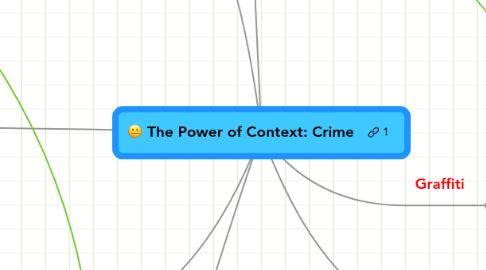
1. Energy Efficient
2. New York
2.1. Environment of the City
2.1.1. Urban
2.1.2. Crowded
2.1.2.1. Overpopulated
2.1.3. Built Up
2.1.3.1. Skyscrapers
2.1.4. Public Transport
2.1.4.1. Subway
2.1.5. Polluted
2.1.5.1. Little Green Space
2.1.6. High Crime Rate
2.1.6.1. Drugs
3. Broken Window Theory
3.1. "Crime is the Inevitable Result of Disorder"
3.1.1. Graffiti
3.1.2. Public Disorder
3.1.3. Aggressive Panhandling
3.1.3.1. Invitations to More Serious Crime
3.1.3.1.1. Subway
3.1.3.2. Small Goals
4. Subways
4.1. Fare-beating
4.1.1. Uniformed Officers at Turnstyles
4.2. Quality of Life Crimes
4.3. Graffiti
4.4. Overcrowding
4.5. Terrorism
4.6. Station Design
5. Environment
5.1. Good
5.1.1. Clean
5.1.2. Safe
5.1.3. Light
5.1.4. Recycling
5.2. Bad
5.2.1. Dark
5.2.2. Littered
5.2.3. Vandalism
5.2.4. Intimidating
6. Atmosphere
6.1. Senses
6.1.1. Sight
6.1.1.1. Lighting
6.1.1.1.1. Soft
6.1.1.1.2. Natural
6.1.1.2. Aesthetics
6.1.1.2.1. Pleasing
6.1.1.2.2. Comfortable
6.1.1.2.3. Functional
6.1.1.3. Surroundings
6.1.1.3.1. Plants
6.1.1.3.2. Windows
6.1.2. Smell
6.1.2.1. Clean
6.1.2.1.1. Soap
6.1.2.1.2. Lemon
6.1.2.2. Fresh
6.1.2.2.1. Bread
6.1.2.2.2. Coffee
6.1.2.3. Airy
6.1.2.3.1. Outdoors
6.1.3. Taste
6.1.3.1. Food
6.1.3.2. Drink
6.1.3.3. Clarity of Air
6.1.4. Hearing
6.1.4.1. Music
6.1.4.1.1. Soothing
6.1.4.1.2. Energising
6.1.4.2. Silence
6.1.4.2.1. Peace
6.1.4.3. Speakers
6.1.4.3.1. Clear
6.1.4.3.2. Easy to Understand
6.1.5. Touch
6.1.5.1. Texture
6.1.5.1.1. Sensual
6.1.5.2. Temperature
6.1.5.2.1. Warmth
6.1.5.2.2. Cool
7. Graffiti
7.1. Tags
7.2. Gangs
7.3. Crime
7.3.1. Drugs
